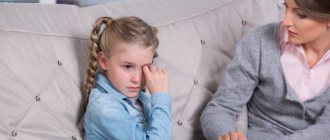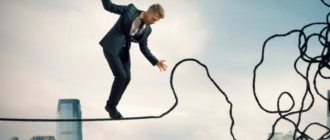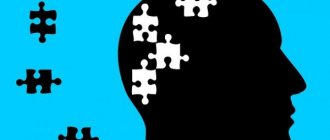Fear is a strong negative emotion that arises as a result of an imagined or real danger and poses a threat to life for the individual. In psychology, fear is understood as the internal state of a person, which is caused by a perceived or real disaster.
Psychologists attribute fear to emotional processes. K. Izard defined this state as a basic emotion that is innate and has genetic and physiological components. Fear mobilizes the individual's body to avoid behavior. A person’s negative emotion signals a state of danger, which directly depends on numerous external and internal, acquired or congenital reasons.
Psychology of fear
Two neural pathways are responsible for the development of this feeling, which must function simultaneously. The first is responsible for basic emotions, reacts quickly and is accompanied by a significant number of errors. The second one reacts much slower, but more accurately. The first way helps us quickly respond to signs of danger, but often works as a false alarm. The second way makes it possible to more thoroughly assess the situation and therefore respond more accurately to the danger.
In the case of a feeling of fear in a person who is initiated by the first path, the functioning of the second path occurs, which evaluates some signs of danger as unreal. When a phobia occurs, the second pathway begins to function inadequately, which provokes the development of a feeling of fear of stimuli that are dangerous.
When to seek help from a psychologist
Among people who love the feeling of fear, there are also adrenaline junkies. They constantly risk their own lives; if they give up this dangerous occupation, they begin to feel sad and depressed. Some of these people may need the help of a professional psychologist.
It is believed that such people take risks instead of love, communication, and the desire to enter into a relationship.
There are also people who believe that adrenaline junkies subconsciously strive for death. This is a very controversial opinion, but a person should talk to a specialist, otherwise the problem of fear and its incorrect implementation can lead to tragic consequences.
Video about ADME and find out what you are afraid of.
Causes of fear
In everyday life, as well as in emergency situations, a person is faced with a strong emotion - fear. A negative emotion in a person represents a long-term or short-term emotional process that develops due to an imaginary or real danger. Often this condition is marked by unpleasant sensations, at the same time being a signal for protection, since the main goal facing a person is to save his own life.
But it should be borne in mind that the response to fear is the unconscious or thoughtless actions of a person, which are caused by panic attacks with the manifestation of severe anxiety. Depending on the situations, the course of the emotion of fear in all people varies significantly in strength, as well as in its influence on behavior. Finding out the reason in a timely manner will significantly speed up getting rid of negative emotions.
The causes of fear can be both hidden and obvious. Often a person does not remember the obvious reasons. Hidden fears are understood as fears that come from childhood, for example, increased parental care, temptations, a consequence of psychological trauma; fears caused by a moral conflict or unresolved problem.
There are cognitively constructed reasons: feelings of rejection, loneliness, threats to self-esteem, depression, feelings of inadequacy, feelings of imminent failure.
Consequences of negative emotions in a person: strong nervous tension, emotional states of uncertainty, search for protection, prompting the individual to escape, save. There are basic functions of people’s fear, as well as accompanying emotional states: protective, signaling, adaptive, search.
Fear can manifest itself in the form of a depressed or excited emotional state. Panic fear (horror) is often marked by a depressed state. Synonyms for the term “fear” or similar terms are the terms “anxiety”, “panic”, “fright”, “phobia”.
If a person has a short-term and at the same time strong fear caused by a sudden stimulus, then it will be classified as fear, and a long-term and not clearly expressed one will be classified as anxiety.
Conditions such as phobias can lead to frequent and strong experiences of negative emotions by an individual. A phobia is understood as an irrational, obsessive fear associated with a certain situation or object, when a person cannot cope with it on his own.
Classification
Sexual phobias
- Philophobia – fear of falling in love, experiencing a strong feeling;
- Oneirogmophobia – fear of night ejaculation;
- Gamophobia – fear of getting married, entering into a legal union;
- Contreltophobia – fear of sexual violence;
- erotophobia – fears about intimacy;
- Virginitiphobia – fear of being raped;
- Cypridophobia – fear of prostitutes, fear of contracting a sexually transmitted disease;
- Philemaphobia – fear of kissing;
- Primeisodophobia – fear of losing innocence.
Fears related to the human body
- Phalacrophobia – fear of hair falling out;
- odontophobia – fears about any manipulation of teeth and visits
- dental office;
- euphobia (Gertuphobia) – fear of one’s own and others’ knees;
- Levophobia – fear of body parts located on the left;
- dextrophobia (Oextro phobia) – fear of body parts located on the right;
- medomalacuphobia – fear of losing potency;
- Chirophobia - unpleasant sensations due to someone else's hands;
- Ommetaphobia – anxiety about looking into another person’s eyes;
- Gymnophobia – fear of the sight of a naked body;
- Rhytiphobia – fear of wrinkles;
- dysmorphophobia – fear of flaws in one’s body;
- Chaetophobia – fear of any hair;
- Medorthophobia – fear of the male genital organ;
- Osmophobia – fear of body odors;
- Hemophobia – aversion to blood.
Concerns about specific locations
- Scolinophobia – rejection from school;
- Gephyrophobia – fear of being on a bridge;
- nosocomephobia – fears about staying in medical institutions;
- Eicophobia – fear of being at home;
- Batophobia – fear of elevated buildings;
- lygrophobia (Lygophobia) – neurosis due to a darkened room, poorly lit areas;
- Ecclesiophobia – worries about church organizations;
- topophobia – neurosis in specific objects;
- Domatophobia – neurosis due to all the buildings in a row;
- Theatrophobia – serious worries about theater performances or the theater stage;
- Atephobia – fear of destroyed houses and buildings;
- Nyctohylophobia – fear of dense, gloomy forests;
- Koinoniphobia – worries about being in any room;
- Hagiophobia - neurosis due to religious rituals and ceremonies, shrines, clergy.
Phobias due to natural phenomena
- Scotophobia – neurosis due to darkness;
- Auroraphobia – fear of the northern lights;
- Cremnophobia - neuroses due to an abyss, abyss, ravine, slope;
- Nephophobia – dislike of clouds;
- sciopophobia – fear of shadows;
- Homichlophobia – neurosis in front of fog;
- Lilapsophobia – experiences before a hurricane, storm;
- Chionophobia – fear of snow cover;
- Ancraophobia – neurosis due to drafts and wind;
- Ligyrophobia – fear caused by sharp sounds;
- Nyctophobia - neurosis in front of the night, a dark room;
- acrophobia – fear of being above the ground;
- Ombrophobia – fear of heavy rain;
- Brontophobia – fear caused by lightning and thunderstorms;
- anemophobia – fear that arises due to significant air gusts or storms;
- Cryophobia is a neurosis due to the coming frosts in winter.
Fear of color
- Chromophobia – a neurotic condition due to all shades and colors;
- Leukophobia – a neurotic condition due to the color white;
- porphyrophobia – a neurotic condition due to the color purple;
- xanthophobia (Xanlhophobia) – a neurotic condition due to the color yellow;
- erythrophobia (Erythrophobia) – a neurotic condition due to the color red;
- Melanophobia (Metanophobia) is a neurotic condition due to the color black.
Social phobias
- Isolophobia – fear of being alone;
- Teleophobia – neurosis due to religious rituals, religion itself;
- Katagelophobia – fear of being ridiculed;
- Deipnophobia – worries about upcoming conversations at the table during meetings with guests;
- Athazagoraphobia – fear of being unnoticed and ignored;
- Enissophobia – neurosis due to criticism;
- Ochlophobia – fear of crowds;
- aphenphosmophobia - neurosis from other people's touches;
- Liticaphobia – fear of legal proceedings, exposure;
- scoptophobia – excessive isolation, fear of being funny in the opinion of others;
- Eupophobia – fear of receiving positive news.
Fear of insects
- Arachnephobia – neurosis due to a spider;
- parasitophobia (Parasitophobia) – a neurotic state due to a parasitic insect, hostility to bedbugs and lice;
- Myrmecophobia – dislike of ants;
- Acarophobia – neurosis due to insects and ticks;
- Mottephobia – dislike of moths;
- Apiphobia – neurosis due to the expectation of getting a bee sting.
Phobias due to numbers
- Octophobia – fear of the number 8;
- Triskadekaphobia – neurosis due to the number 13;
- Numerophobia – worries about every number.
Phobias associated with death
- Thanatophobia - neurosis about the thought of one’s sudden death and funeral;
- Coimetrophobia – neurosis due to the cemetery;
- Sellophobia – fear of the processes that occur with the body after burial;
- necrophobia - neurosis due to funeral rites, fear of the dead;
- Taphephobia – fear of being buried alive;
- plakophobia (Ptacophobia) – neurosis due to gravestones.
Fear of space
- Stenophobia – avoidance of narrow, cramped corridors;
- Aeroacrophobia – neurosis due to high open areas;
- Spacephobia – neurosis due to empty rooms, emptiness;
- Agoraphobia – fear of open spaces;
- Cenophobia – worries about empty rooms;
- Agyrophobia – panic in front of the road and streets;
- Claustrophobia – terror in a confined space.
Phobias in front of abstract concepts:
- Technophobia – electronic devices and new technologies cause horror;
- logophobia (Logophobia) – neurosis when it comes to the need to speak out;
- dikephobia (Dikepbobia) – fear that the truth will be restored;
- hylephobia (Hylepnobia) – neurosis due to materialism;
- apeirophobia - neurosis due to infinity, limitlessness of space;
- Ideophobia – fears due to thoughts;
- psychophobia (Psychophobia) – hostility towards the mentally ill;
- symmetrophobia – neurosis due to symmetry;
- allodoxaphobia – neurosis due to other people’s opinions;
- heresyphobia – unconventional ideas cause panic;
- Ouranophobia – fear of looking at the sky;
- Melophobia – neurosis due to loud music;
- Satanophobia – fear of evil spirits, evil, the coming of the devil;
- Mythophobia - experiences due to traditions, myths, legends;
- Cainophobia – fears about everything new: things, feelings;
- Gnosiophobia (Gnosiophobta) – new knowledge and information causes panic;
- Philosophobia – neurosis due to philosophical ideas;
- metrophobia – poetry causes horror;
- Hadephobia – fear of going to hell;
- prosophobia (Prosophobta) – worries about progress;
- Theologicophobia – religious teachings cause stress;
- demonophobia (Demonophobia) – worries about demons, evil spirits;
- phasmophobia (Phasmoprtobia) – neurosis due to ghosts, ghosts;
- Nomatophobia – fear of calling someone by name;
- Hellenologophobia – a neurotic condition due to the presence of scientific terms;
- Theophobia - fear of receiving divine punishment, a fateful blow, punishment from religion, God;
- Symbolophobia – fear of symbols, phenomena, objects, events, prophetic dreams and omens.
Phobias of people of other nationalities
- Teutophobia – neurosis due to Germans, Germany and everything German;
- Japanophobia - neurosis due to the people of Japan and everything Japanese;
- Heliophobia – neurosis due to Greece, Greek traditions;
- Russophobia – neurosis due to Russia and everything Russian;
- Judeophobia – neurosis due to Jews and everything Jewish;
- Anglophobia – neurosis due to Great Britain as a whole;
- Francophobia - neurosis due to the inhabitants of France and everything French;
- Sinophobia – neurosis due to the people of China and everything Chinese;
- xenophobia – fear of representatives of a different religion, cultural development,
- states and nations.
Fear of fauna inhabiting water bodies
- Ichthyophobia – fish make you nervous;
- selachophobia (Selachophobta) – panic about sharks;
- Bufonophobia – dislike of toads;
- Ophidiophobia – dislike of reptiles;
- scoleciphobia – dislike of worms;
- herpetophobia – dislike of snakes and lizards;
- Batrachophobia – dislike of frogs;
- Ostraconophobia – dislike of shellfish.
Phobias due to others
- Teratophobia – people with an underdeveloped physical appearance, freaks cause panic and fear that a sick child will be born;
- Wiccaphobia – worries about sorcerers and witches;
- harpaxophobia – fear of being robbed, neurosis due to thieves;
- Pogonophobia – a person with a beard is terrifying;
- Gynophobia – dislike of ladies;
- androphobia - dislike of gentlemen;
- heterophobia (Heterophobia) – avoidance of people of the opposite sex;
- Peladophobia – people with shaved skulls are terrifying;
- Eisoptrophobia – neurosis due to one’s own mirror image;
- parthenophobia (Parthenophobia) – neurosis due to a chaste girl;
- Dentophobia – neurosis due to dental treatment, fear of the dentist;
- Hobophobia – people in distress cause panic;
- Coulrophobia (Coulrophobla) – clowns make you nervous;
- Anthropophobia – neurosis due to all people in general;
- Syngenesophobia – fears due to the presence of a loved one;
- Homophobia – homosexuals make people nervous;
- politicophobia (Politicophobia) – anxiety due to being next to a person from the political sphere;
- ephebiphobia – makes young people and teenagers nervous;
- Pedophobia – dislike of a child;
- gerontophobia (Gerontophobia) – old people and elderly people are afraid of it;
- Pentheraphobia – makes the mother-in-law or mother-in-law nervous.
Animal concerns
- Lutraphobia – makes otters nervous;
- Alektorophobia – roosters and hens make you nervous;
- Ornithophobia – birds make you nervous;
- doraphobia – wool and fur cause panic;
- Cynophobia – dogs make you nervous;
- aclurophobia – makes cats nervous;
- Taurophobia – cows and bulls make you nervous;
- Zemmiphobia – makes rats nervous;
- musophobia – neurosis due to the mouse;
- Hippophobia – dislike of horses;
- agrizoophobia – fear of street and forest animals;
- Zoophobia - fear of all representatives of fauna.
Phobias caused by food
- Oenophobia – neurosis due to the type of wine;
- Lachanophobia – neurosis due to vegetables;
- Cibophobia – fear of eating;
- Carnophobia – intolerance to meat products;
- Alliumphobia – neurosis due to garlic;
- Methyphobia – experiences due to alcoholic beverages.
Fears of doing certain activities
- Ergophobia – neurosis due to performing work that requires special knowledge and experience;
- dipsophobia – fear of drinking any liquid;
- macrophobia (Macrophobia) – neurosis due to expectation of something;
- Vestiphobia – fear of choosing clothes for certain purposes, wearing them under weather conditions;
- Phronemophobia – fears due to the need to think;
- agyrophobia - neurosis due to the need to cross a street or highway;
- Mageirocophobia – neurosis due to cooking;
- Hodophobia – fear of traveling, making a trip;
- Paralipophobia – fear of not doing what was promised, of failing;
- graphophobia - fear of writing something;
- phonophobia – fear of making a phone call;
- Glossophobia – fear of speaking in front of crowds of people;
- optophobia (Optophobia) – fear of seeing something repulsive, hostile, being scared;
- Kleptophobia – fear of stealing something;
- Enosiophobia – fear of breaking religious commandments, sinning;
- Cyberphobia – fear of computer technology;
- Somniphobia – fear of falling asleep;
- Katisophobia – fear of sitting down;
- Ergasiophobia – worry about a planned action or behavior;
- Doxophobia – fear of voicing one’s position;
- Ambulophobia – fear of walking;
- Maleusiophobia – neurosis due to the onset of labor and contractions;
- Pharmacophobia – fear of taking medications;
- Chorophobia – fear of performing dance movements;
- amaxophobia – fear of driving;
- Tropophobia – fear of moving to another apartment and the associated changes;
- Clinophobia – fear of falling asleep;
- urophobia – fear of urinating in the wrong place;
- Decidophobia – fear of deciding something;
- Kinetophobia – fear of movement;
- Laliophobia – neurosis before speaking;
- Sophophobia – neurosis due to studying, visiting educational institutions;
- Abultophobia – neurosis due to washing, bathing, and performing water procedures;
- nostophobia – fear of returning home;
- Dishabillophobia – neurosis due to public nudity or removal of an item of clothing.
Phobias due to specific objects
- Motorophobia – fear of cars and driving them;
- Crystallophobia – fear of glass and crystal products;
- Aichmophobia – fear of cutting and piercing objects, needles, knives and pointed parts;
- Chrometophobia – fear of money;
- Bibliophobia – fear of reading books;
- siderodromophobia - fear of trains;
- Aerophobia – fear of flying on airplanes;
- pediophobia (Pediophobia) - neurosis due to life-size figures, dolls, wax figures - objects depicting a model of a person;
- Hoplophobia – fear of bladed weapons and firearms;
- Telephonophobia – fear of using the telephone;
- Ballistophobia – fear of bombs, shells, bullets, rockets, throwing objects;
- Microphobia – fear of small details;
- Textophobia – fears about fabrics and textiles;
- Enetophobia – fear of piercing objects, pins, etc.;
- neopharmaphobia – fear of taking new medications;
- Cyclophobia – fear of bicycles, two-wheeled mode of transport;
- asymmetriphobia – fear of objects with asymmetry;
- nucleomituphobia (IMucleomituphobia) – fears due to threats of nuclear war, the use of nuclear weapons;
- Mechanophobia – fear of mechanical objects, machines;
- Papyrophobia – fear of paper, clean and wet, dirty;
- Xyrophobia – fear of razors;
- Chronometrophobia – fear of clock mechanisms, the passage of time;
- Megalophobia – fear of huge objects;
- Cyberphobia – fear of electronic equipment, computers.
Fears due to sunlight or other light
- Photophobia – intolerance to any light sources;
- Electrophobia – fear of the electrical system;
- xerophobia – fear of deserts, dry climates;
- Selaphobia – fear of a sharp flash of light;
- photoaugliaphobia (Photoaugliaphobia) – fear of strong lighting;
- Heliophobia – fear of direct exposure to sunlight;
- Eosophobia – fear of dawn, the beginning of a new day;
- Phengophobia – fear of objects that shine from the sun's rays.
Phobias before an emergency
- Rhypophobia – fear of dirt, lack of cleanliness, pollution;
- hypnophobia (Hypnopliobia) – fear of sleeping due to fear of dying;
- Pnigophobia – fear of suffocation;
- Mastigophobia – neurosis due to corporal punishment, spanking;
- Anginophobia – fear of angina, suffocation or choking;
- Rhabdophobia – fear of physical or mental punishment;
- Dystychiphobia – fear of accidental tragedy;
- tomophobia – neurosis due to the likelihood of surgical intervention;
- Atomosophobia – fear of a nuclear explosion;
- Merinthophobia – neurosis due to rope;
- Radiophobia – fear of receiving radioactive radiation.
Neurosis due to certain conditions
- Atychiphobia – fear of failure;
- Zelophobia – fear of jealousy;
- cherophobia – neurosis due to the upcoming fun;
- Dinophobia – fear of dizziness and nausea;
- Menophobia – fear of menstruation and accompanying pain;
- Atelophobia – fear of not conforming to perfection, ideal;
- Mnemophobia – fear due to past events;
- eleutherophobia (Eleutherophobta) – neurosis due to freedom;
- Hypengyophobia – fear of unnecessary responsibility;
- obesophobia – fears of being overweight;
- asthenophobia – fear of losing strength, energy, being weak;
- Leniaphobia (Peniaphobia) – fear of becoming poor;
- Plutophobia – fear of getting rich;
- Angrophobia – fear of experiencing and receiving rage and anger from others;
- Soteriophobia – fear of being dependent on others;
- Doxophobia – fear of expressing gratitude, expressing your opinion;
- Illyngophobia – fear of feeling dizzy if you look down;
- monophobia – fear of being alone;
- gerontophobia – neurosis due to old age and accompanying weaknesses and illnesses;
- Oneirophobia – fear of dreaming;
- Hedonophobia - neurosis due to receiving pleasure, pleasure, joy;
- Kopophobia – fear of overwork;
- alginophobia (Algiophobia) – fear of experiencing pain;
- Hormephobia – neurosis due to random stress and the appearance of shock.
Phobias of certain substances
- Iophobia (iophobia) – fear of poisoning from poison;
- Seplophobia – neurosis due to rot;
- aurophobia – fear of gold and products made from it;
- metallophobia – neurosis due to metal and objects made from it;
- amatophobia (Amathophobia) – fear of dusty surfaces, constant cleaning;
- Coprophobia – fear and aversion due to feces.
Water fears:
- Potamophobia - neurosis due to river flows, waterfalls;
- Antlophobia – fears due to the risk of floods;
- Thalassophobia – neurosis due to bathing, swimming in the oceans, seas;
- hydrophobia (Hydrophobia) – neurosis due to water, approaching a body of water, the occurrence of convulsive movements when swallowing;
- Limnophobia – neurosis due to the depth of lakes.
Fear of the forest or nature:
- Dendrophobia – neurosis due to a large number of trees;
- Anthrophobia – neurosis due to flowers;
- Mycophobia – fear of being poisoned by mushrooms;
- hylophobia (Hyiophobia) – neurosis due to forests;
- Olfactophobia – fear of smells;
- Botanophobia – neurosis due to flora.
Phobias before illnesses
- Cardiophobia – fear of having a heart attack, heart disease;
- Dementophobia – fear of clouding of mind, madness;
- Toxicophobia – fear of getting poisoned, intoxicating the body;
- amnesiphobia – fear of losing memory;
- paraphobia – fear of deviations in sexual development;
- Luiphobia – fear of contracting syphilis;
- Diabetophobia – fear of diabetes;
- Molysmophobia – fear of contracting infectious diseases;
- Verminophobia – neurosis due to infection from microbes and viruses;
- Scotomaphobia – fear of losing vision;
- Coprastasophobia – fear of constipation, stool retention;
- epistaxiophobia – fear of having a runny nose;
- monopathophobia (Mohopathophobia) – fear of a certain disease;
- Anginophobia – neurosis due to angina;
- cancerophobia (Cancerophobia) – fear of getting cancer, oncology;
- patroiophobia – neurosis due to genetic diseases;
- Febriphobia – fear of colds and flu;
- Proctophobia – fear of getting hemorrhoids;
- Cynophobia – fear of contracting rabies from dogs;
- Vaccinophobia – neurosis due to vaccination;
- traumaticphobia – fear of injury or physical harm;
- Acarophobia – fear of getting a tick bite, infection from small insects, scabies and itchy skin;
- phobia (Phobophobia) - neurosis due to the appearance of a phobia, obtaining an obsessive state of neurosis;
- Pathophobia – fear of getting sick;
- Leprophobia – fear of getting leprosy, leprosy;
- Phthisiophobia – fear of contracting tuberculosis;
- Cypridophobia – fear of contracting sexually transmitted diseases;
- Chorophobia – fear of getting cholera;
- Poliosophobia – fear of possible kidney disease, polio;
- Dermatosiophobia – fear of contracting a skin disease;
- Phthiriophobia – fear of lice infestation;
- meningitophobia – fear of getting a brain disease;
- Trypanophobia – fear of getting injured or getting an injection.
The list of phobias that are common to people is very diverse. Unfortunately, a person is not able to control his own fears and completely get rid of them. But with the help of specialist psychologists or psychotherapists, it is possible to reduce the problem and make your life easier.
Signs of fear
Some features of the expression of negative emotions are manifested in physiological changes: increased sweating, rapid heartbeat, diarrhea, dilation and constriction of the pupils, urinary incontinence, darting eyes. These signs appear when there is a threat to life or in front of a characteristic biological fear.
Signs of fear are forced silence, passivity, refusal to act, avoidance of communication, uncertain behavior, the appearance of a speech defect (stuttering) and bad habits (looking around, stooping, biting nails, fiddling with objects); the individual strives for solitude and isolation, which contributes to the development of depression, melancholy, and in some cases provokes suicide. People who experience fears complain of obsession, which ultimately prevents them from living a full life. Obsession with fear interferes with initiative and forces inaction. Deceptive visions and mirages accompany a person; he is afraid, tries to hide or run away.
Sensations that arise during a strong negative emotion: the ground disappears from under your feet, adequacy and control over the situation are lost, internal numbness and numbness (stupor) occurs. A person becomes fussy and hyperactive, he always needs to run somewhere, because it is unbearable to be alone with the object or problem of fear. A person is squeezed and dependent, stuffed with insecurity complexes. Depending on the type of nervous system, the individual defends himself and goes on the offensive, showing aggression. In essence, this acts as a disguise for experiences, addictions and anxieties.
Fears manifest themselves in different ways, but have common features: restlessness, anxiety, nightmares, irritability, suspicion, suspiciousness, passivity, tearfulness.
What to do if you have causeless anxiety and worry
It's hard to live in constant stress. If you are experiencing causeless anxiety and fear, the following list will tell you what to do:
- Talk to someone you trust. This could be a relative, a close friend, a psychotherapist or a helpline employee. People are social creatures, so communication is a good way to relieve internal stress.
- Find a way to calm down quickly. There is not always someone nearby with whom you can share. Therefore, it is important to find a suitable method that will help you relax: breathing techniques, soothing music, aromatherapy, self-massage and more. If you cannot independently choose a technique that quickly helps with anxiety for no reason, a specialist will tell you what to do.
- Add physical activity to your life. It is a natural and effective remedy for anxiety. Moderate exercise relieves tension, reduces stress hormones and strengthens the nervous system. Get at least 30 minutes of exercise every day.
- Normalization of lifestyle. Get enough sleep, eat well, give up bad habits. This stabilizes physical performance and neurotransmitter levels, which helps maintain emotional balance.
- Start keeping a journal. Taking notes can help you identify patterns of anxiety flare-ups, understand the causes, and spot early signs of them. Also, thanks to this, you will begin to focus more on positive events that you may not have noticed before.
When worried for no reason, everyone who regularly encounters this wants to know what to do. There is no universal method, but the 5 steps listed above are recommended for every person with increased anxiety. This may be enough to alleviate symptoms. But if self-help techniques do not give the desired effect, then if you regularly experience anxiety for no reason, you need to find out what to do from a specialist.
Types of fears
Yu.V. Shcherbatykh identified the following classification of fears. The professor divided all fears into three groups: social, biological, existential.
He included in the biological group those that are directly related to a threat to human life, the social group is responsible for fears and fears in social status, the scientist associated the existential group of fears with the essence of man, which is observed in all people.
All social fears are caused by situations that can undermine social status and lower self-esteem. These include fear of public speaking, responsibility, and social contacts.
Existential fears are associated with the individual’s intellect and are caused by reflection (reflection on issues that affect the problems of life, as well as death and human existence itself). For example, this is fear of time, death, as well as the meaninglessness of human existence, etc.
Following this principle: fear of fire will be classified as a biological category, stage fright as a social category, and fear of death as an existential category.
In addition, there are also intermediate forms of fear that stand on the border between two groups. These include fear of disease. On the one hand, the disease brings suffering, pain, damage (biological factor), and on the other, a social factor (separation from society and the team, exclusion from usual activities, decreased income, poverty, dismissal from work). Therefore, this condition is referred to as the border of the biological and social group, fear of swimming in a pond on the border of the biological and existential, fear of losing loved ones on the border of the biological and existential group. It should be noted that in every phobia all three components are noted, but one is dominant.
It is common for an individual, and this is normal, to be afraid of dangerous animals, certain situations, as well as natural phenomena. People's fears about this are reflexive or genetic in nature. In the first case, the danger is based on negative experience, in the second it is recorded at the genetic level. Both cases control reason and logic. Presumably, these reactions have lost their useful meaning and therefore greatly interfere with a person’s ability to live fully and happily. For example, it makes sense to be careful around snakes, but it is foolish to be afraid of small spiders; One can be justifiably afraid of lightning, but not thunder, which is incapable of causing harm. With such phobias and inconveniences, people should rebuild their reflexes.
People's fears that arise in situations that are dangerous to health and life have a protective function and are therefore useful. And people’s fear of medical procedures can harm their health, since they will prevent timely diagnosis of the disease and initiation of treatment.
People's fears are varied, as are their areas of activity. A phobia is based on the instinct of self-preservation and acts as a defensive reaction in the face of danger. Fear can manifest itself in various forms. If a negative emotion is not clearly expressed, then it is experienced as a fuzzy, vague feeling - anxiety. Stronger fear is noted in negative feelings: horror, panic.
Why are we afraid?
If we weren’t afraid, we wouldn’t live long: we would go out onto the road right under cars and squeeze poisonous snakes. The purpose of fear in humans and all animals in general is to promote survival. During human evolution, people who feared what was right survived to pass on their genes, causing the fear trait and response to it to be selected for by evolution as beneficial.
Why do people make a special grimace of fear when they are scared? Charles Darwin said that this is the result of instinctive muscle tension caused by a developed reaction to fear. To prove his point, he went to the reptile house at the London Zoological Gardens. Trying to remain completely calm, he stood as close to the glass as possible, and from the other side a viper rushed towards him. Every time she got too close, Darwin winced and jumped away.
Most of us are no longer fighting for our lives in the wild, but fear is far from an outdated instinct. Today it serves the same purpose as the day before yesterday, when we could come across a wild animal while collecting. The more modern decision not to take a shortcut through a deserted courtyard at night is based on rational fear, which promotes survival. Only the incentives have changed, but we are in as much danger today as we were hundreds of years ago, and our fear protects us just as much as it did then.
Besides instinct, people have other factors associated with fear. Thus, humans have the “gift of anticipation”: we anticipate terrible things that might happen, things we have heard about, read about, or seen on TV. Most of us have never experienced a plane crash, but that doesn't stop us from sitting on a plane and being afraid. At the same time, anticipating a frightening stimulus can cause the same reaction as experiencing it—this is also an evolutionary advantage. Those people who, having felt the rain, waited for lightning and stayed in the cave, had a better chance of not being shocked by electricity of thousands of volts.
State of fear
Negative emotion is a normal individual response to the vicissitudes of life. In an implicit, expressed form, this state acts as an adaptive reaction. For example, an applicant cannot successfully pass an exam without experiencing excitement and any anxiety. But in extreme terms, the state of fear deprives the individual of the ability to fight, giving a feeling of horror and panic. Excessive excitement and anxiety do not allow the applicant to concentrate during the exam, he may lose his voice. Researchers often note a state of anxiety and fear in patients during an extreme situation.
The state of fear can be relieved for a short time by sedatives and benzodiazepines. A negative emotion includes a state of irritability, horror, absorption in certain thoughts, and is also marked by changes in physiological parameters: the appearance of shortness of breath, excessive sweating, insomnia, chills. These manifestations intensify over time and thereby complicate the patient’s normal life. Often this condition becomes chronic and manifests itself in the absence of a specific external reason.
From indifference to phobia ↑
There are 3 degrees of human response to external stimuli:
- Fearlessness, slight apprehension, indifference . Such emotions are fortunate to be experienced either by those who do not know what they are doing (forgivable for them), or with an atrophied sense of self-preservation or exaggerated confidence in happiness and, or, on the contrary, those who are tired of living. An extreme, abnormal condition.
- Fear warning of danger . Needless to say, this healthy, normal sense of self-preservation has so far saved our civilization from extinction. Is it abnormal to fear for your loved ones, warning them of danger? Fear war and do everything to prevent it from happening. Be afraid of bee stings and wear protective clothing.
- Panic, phobia . The same extreme level of fear, only with the opposite amplitude. In this state, it is not the person who controls their feelings, but they control them. Fear is spreading. A sick person (deviation from the norm - illness) is already afraid of fear itself, his consciousness is subject only to internal panic. Get a phobia.
Feeling of fear
The emotion of fear would be more accurate, but there is no clear boundary between these two concepts. Often, when there is a short-term effect, they talk about emotion, and when there is a long-term effect, they mean a feeling of fear. This is where the two concepts differ. And in colloquial speech, fear is classified as both a feeling and an emotion. Fear manifests itself in different ways in people: for some it constrains and limits, while for others, on the contrary, it intensifies activity.
The feeling of fear is individual and reflects all genetic characteristics, as well as the characteristics of upbringing and culture, temperament, accentuation, and neuroticism of each individual person.
There are both external and internal manifestations of fear. External refers to how an individual looks, while internal refers to the physiological processes occurring in the body. Because of all these processes, fear is classified as a negative emotion, which negatively affects the entire body, increasing the pulse and heartbeat, accordingly increasing blood pressure, and sometimes vice versa, increasing sweating, changing the composition of the blood (releasing the hormone adrenaline).
The essence of fear is that an individual, being afraid, tries to avoid situations that provoke negative emotions. Strong fear, being a toxic emotion, provokes the development of various diseases.
Fears are observed in all individuals. Neurotic fear is observed in every third inhabitant of the Earth, but if it reaches the strength of affect, it turns into horror and this takes the individual out of control of consciousness, and as a result, numbness, panic, defensive aggression, flight. Therefore, the emotion of fear is justified and serves for the survival of the individual, however, it can also take pathological forms that will require the intervention of doctors. Each fear performs a specific function and arises for a reason.
Fear of heights protects you from falling from a mountain or balcony; fear of getting burned makes you not go close to the fire, and, therefore, protects you from injury. Fear of public speaking forces you to prepare more carefully for speeches and take rhetoric courses, which should help in career growth. It is natural that an individual tries to overcome personal fears. If the source of danger is uncertain or unconscious, then the state that arises is called anxiety.
A person is one who is able to feel
Have you ever seen a fish with an anxiety disorder, a sparrow in mortal anguish, or a toad in a panic attack? Rational nature controls animals through a coordinated intraspecific instinct. This allows each species to safely survive and reproduce. We are not talking about any “sentiments” here.
The only one whom nature has endowed with a sensual form of life is man. We gladly accept this gift when emotions bring pleasure. When we soar on the wings of love, we experience tenderness and passion, inspiration and joy.
Another thing is human fears, this “dark side” of our sensuality. No one wants to shake when they see spiders, panic when trying to leave the house, or suffer from epileptic seizures when boarding a plane. In modern human life, fears significantly limit our capabilities. They narrow the ability to live every available moment with joy.
And here we have many questions for nature. Is fear a natural emotion or an unnecessary burden? Why are we created this way?
Panic fear
This condition never occurs without reason. For its development, a number of factors and conditions are necessary: apathy, anhedonia, anxiety, depression and anxiety, stress, obsessive-compulsive neurosis, schizophrenia, hypochondria, psychopathy.
A depressed person’s psyche quickly reacts to any stimuli and therefore restless thoughts can undermine a person’s capacity. Anxiety and accompanying conditions gradually turn into neurosis, and neuroses, in turn, provoke the emergence of panic fear.
This condition cannot be predicted, since it can occur at any time: at work, on the street, in transport, in a store. A panic state is the body’s defensive reaction to a perceived or imaginary threat. Panic causeless fear is characterized by the following symptoms: suffocation, dizziness, rapid heartbeat, trembling, stupor, chaos of thoughts. Some cases are marked by chills or vomiting. Such conditions last from an hour to two for one or two times a week. The stronger the mental disorder, the longer and more frequent the panic attacks.
Often this condition can occur against the background of overwork and exhaustion of the body in emotionally unstable people. In most cases, women fall into this category as they are emotional, vulnerable, and react sharply to stress. However, men also experience panic for no reason, but try not to admit it to others.
Panic fear does not disappear on its own, and panic attacks will haunt patients. Treatment is carried out strictly under the supervision of psychiatrists, and relieving symptoms with alcohol only aggravates the situation, and panic will appear not only after stress, but also when nothing threatens.
Fear of pain
Since it is common for a person to periodically fear something, this is a normal reaction of our body, which reflects the performance of protective functions. Frequent experiences of this kind include fear of pain. Having previously experienced pain, the individual at an emotional level tries to avoid a repetition of this sensation and fear acts as a protective mechanism that prevents dangerous situations.
Fear of pain is not only useful, but also harmful. A person, not understanding how to get rid of this condition, tries not to visit the dentist for a long time or avoids an important operation, as well as the examination method. In this case, fear has a destructive function and must be fought against. Confusion about how to effectively get rid of the fear of pain only aggravates the situation and pushes towards the formation of a panic reaction.
Modern medicine currently has various methods of pain relief, so the fear of pain is predominantly only psychological in nature. This negative emotion is rarely formed from previously experienced experiences. Most likely, a person’s fear of pain from injuries, burns, or frostbite is strong, and this is a protective function.
How to deal with phobias?
Starting to fight your fear is often hindered by a reluctance to acknowledge the fact of its existence. Society believes that being afraid of something is stupid and shameful. This makes it more difficult not to deny the presence of a phobia. As a result, fear is driven somewhere far into our subconscious and carefully ignored.
The following ways can help get rid of this sticky, unpleasant feeling:
- Get over yourself. You need to look fear “in the eyes.” Try to survive the situation that seems monstrous and traumatic. Usually people who have managed to change themselves notice that their own idea of how everything will happen turned out to be much worse and more terrible than reality.
- Find the root cause. Try to remember or understand why you have such a fear or phobia. Once you realize this, it will be much easier to understand how to eliminate your fear.
- Visualization . Imagine how successfully you will overcome a difficulty you have, for example, the fear of speaking in public. Think clearly about how you will emerge victorious from the current situation. Having experienced a positive (albeit fictitious) experience, it will be much easier to turn everything into reality.
Treatment of fears
Before starting therapy, it is necessary to diagnose what mental disorder the fears are manifesting. Phobias occur in schizophrenia, hypochondria, depression, in the structure of neurotic disorders, panic attacks, panic disorders.
The feeling of fear occupies a significant place in the clinical picture of somatic diseases (hypertension, bronchial asthma and others). Fear can also be a normal reaction of an individual to the situation in which he finds himself. Therefore, the correct diagnosis is responsible for treatment tactics. The development of the disease, from the point of view of pathogenesis, should be treated in the totality of symptoms, and not in its individual manifestations.
Fear of pain can be effectively treated with psychotherapeutic methods and is eliminated by therapy, which is individual in nature. Many people who do not have special knowledge on getting rid of the fear of pain mistakenly think that this is an inevitable feeling and therefore live with it for many years. In addition to psychotherapeutic methods of treating this phobia, homeopathic treatment is used.
People's fears are very difficult to correct. In modern society, it is not customary to discuss your fears. People publicly discuss illnesses and attitudes towards work, but as soon as you start talking about fears, a vacuum immediately appears. People are ashamed of their phobias. This attitude towards fears has been instilled since childhood.
Correction of fears: take a sheet of white paper and write down all your fears. In the center of the sheet, place the most significant phobia that interferes with your life. And be sure to understand the reasons for this condition.
How to get rid of fear
Every person is able to learn to overcome his fears, otherwise it will be difficult for him to achieve his goals, fulfill his dreams, achieve success and be realized in all directions of life. There are various techniques for getting rid of phobias. It is important to develop the habit of actively acting and not paying attention to the fears that arise along the way. In this case, a negative emotion is a simple reaction that arises in response to any efforts to create something new.
Fear can arise from trying to do something against your beliefs. Understand that each person develops a personal worldview over a certain period of time, and when trying to change it, it is necessary to overcome fear.
Fear can be strong or weak, depending on the power of persuasion. A person is not born successful. We are often not raised to be successful people. It is very important to act despite personal fear. Tell yourself: “Yes, I’m scared, but I will do it.” While you hesitate, your phobia grows, triumphantly turning into a powerful weapon against you. The longer you hesitate, the more you grow it in your mind. But as soon as you begin to act, the fear will immediately disappear. It turns out that fear is an illusion that does not exist.
The cure for fear is to accept your phobia and, resigned, step towards it. You shouldn't fight it. Admit to yourself: “Yes, I’m scared.” There is nothing wrong with this, you have the right to be afraid. The moment you acknowledge it, it rejoices, and then it weakens. And you start taking action.
How to get rid of fear? Assess the worst-case scenario for the expected development of events using logic. When fear appears, think about the worst-case scenario if suddenly, no matter what, you decide to act. Even the worst case scenario is not as scary as the unknown.
What causes fear? Fear's most powerful weapon is the unknown. It seems terrible, cumbersome and impossible to overcome. If your assessment is really real and the terrible condition does not go away, then it is worth thinking about whether in this case the phobia acts as a natural defensive reaction. Maybe you really need to give up further action because your negative emotion is keeping you out of trouble. If the fear is not justified and the worst case scenario is not that bad, then go ahead and act. Remember that fear lives where there is doubt, uncertainty and indecision.
The cure for fear is to remove doubts and there will be no room left for fear. This state has such power because it causes negative images in the consciousness of what we do not need and the person feels discomfort. When a person decides to do something, doubts evaporate instantly, since the decision has been made and there is no turning back.
What causes fear? As soon as fear arises in a person, a scenario of failures and failures begins to scroll through the mind. These thoughts negatively affect emotions, and they control life. The lack of positive emotions greatly influences the emergence of indecisiveness in actions, and time of inaction ingrains the individual’s own insignificance. A lot depends on determination: whether you get rid of fear or not.
Fear keeps the human mind's attention on the negative development of an event, and the decision concentrates on a positive outcome. When making any decision, we focus on how wonderful it will be when we overcome fear and ultimately get a good result. This allows you to have a positive attitude, and the main thing is to fill your mind with pleasant scenarios, where there will be no room for doubts and fears. However, remember that if at least one negative thought associated with a negative emotion arises in your head, then multiple similar thoughts will immediately arise.
How to get rid of fear? Despite the fear, act. You know what you are afraid of, and this is a big plus. Analyze your fear and answer the questions: “What exactly am I afraid of?”, “Is this really worth being afraid of?”, “Why am I afraid?”, “Does my fear have a basis?”, “What is more important for me: making an effort?” over yourself or never achieve what you want?” Ask yourself questions more often. Analyze your phobias, since analysis occurs at a logical level, and fears are emotions that are stronger than logic and therefore always win. Having analyzed and realized, a person independently comes to the conclusion that fear makes absolutely no sense. It only worsens life, making it anxious, nervous and dissatisfied with its results. Are you still afraid?
How to get rid of fear? You can fight fear with feelings (emotions). To do this, sitting comfortably in a chair, scroll through scenarios in your head of what you are afraid of and how you do what you are afraid of. The mind is unable to distinguish imaginary events from real ones. After overcoming the imaginary fear in your head, it will be much easier for you to cope with the given task in reality, since at the subconscious level the model of events has already been strengthened.
The self-hypnosis method, namely visualization of success, will be effective and powerful in the fight against fears. After ten minutes of visualization, you feel better and it is easier to overcome fear. Remember that you are not alone in your phobias. All people are afraid of something. This is fine. Your task is to learn to act in the presence of fear, and not pay attention to it, being distracted by other thoughts. When fighting fear, a person becomes weaker energetically, since the negative emotion sucks out all the energy. A person destroys fear when he completely ignores it and is distracted by other events.
How to get rid of fear? Train and develop courage. If you are afraid of rejection, there is no point in fighting it by trying to minimize the number of rejections. People who are unable to cope with fear reduce such situations to nothing and, in general, do practically nothing, which makes them unhappy in life.
Imagine that training courage is akin to pumping up muscles in the gym. First, we train with a light weight that can be lifted, and then we gradually switch to a heavier weight and try to lift it. A similar situation exists with fears. Initially, we train with minor fear, and then switch to stronger fear. For example, the fear of public speaking in front of a large audience is eliminated by training in front of a small number of people, gradually increasing the audience several times.
The benefits and harms of fear for humans
If a person faces fear, this does not mean that he will have to live with it for the rest of his life. After all, if there were no fear and uncertainty, it would be more difficult for people to survive. From this we can conclude that in some sense fear is useful.
Benefits of fear:
Saves from attacks, accidents, self-harm; this is the main positive function of fear.
It has a positive effect on muscle tone, as the hormone serotonin is produced.
A person begins to think faster and act harmoniously (but some are paralyzed by fear).
The harm of fear:
Restricts movement.
It disrupts the respiratory processes, making breathing confusing and difficult.
A person may make strange, reckless or unfounded decisions when driven by fear.
A panic attack may occur.
Some particularly impressionable people may lose consciousness.
The body becomes tight, this can cause headaches, digestive problems, insomnia, etc.
How to overcome fear?
Practice normal communication: in line, on the street, in transport. Use neutral themes for this. The point is to first overcome small fears, and then move on to more significant ones. Practice constantly.
How to overcome fear using other methods? Boost your self-esteem. There is a certain pattern: the better your opinion of yourself, the fewer phobias you have. Personal self-esteem protects against fears and its objectivity does not matter at all. Therefore, people with high self-esteem are able to do more than people with objective self-esteem. Being in love, people overcome very strong fear in the name of their desires. Any positive emotion helps in overcoming fears, and all negative ones only hinder.











